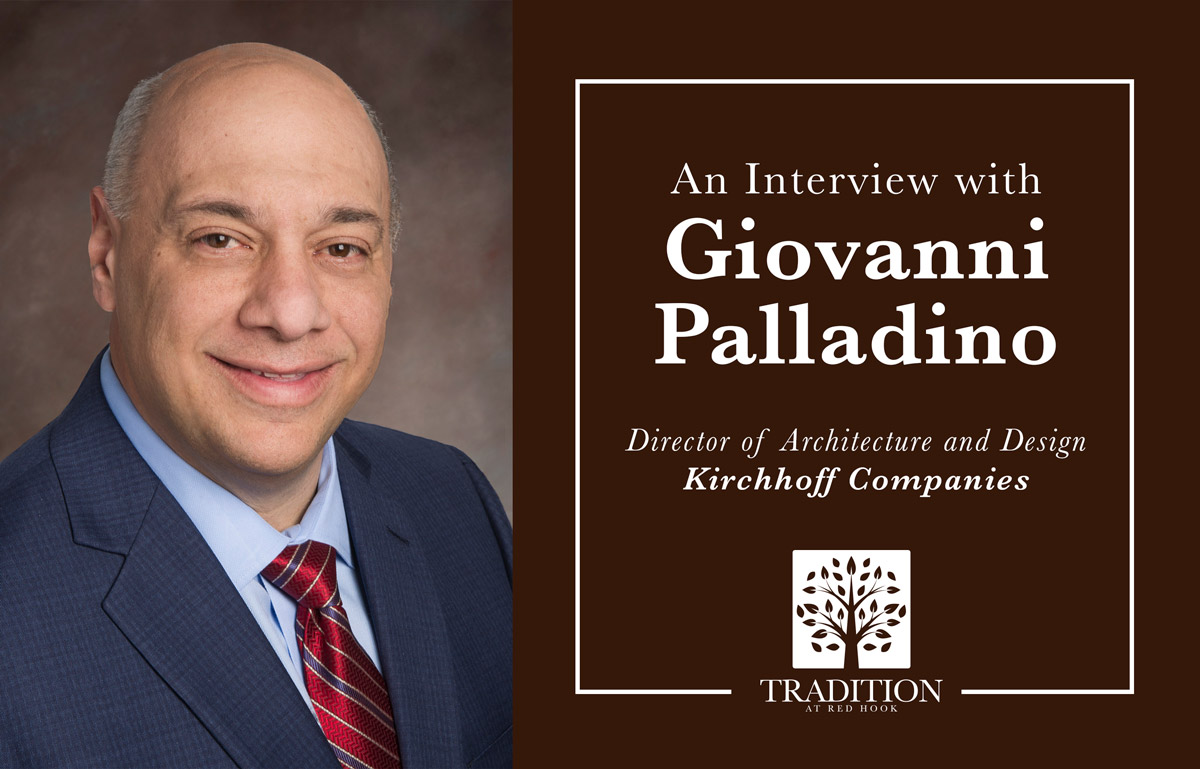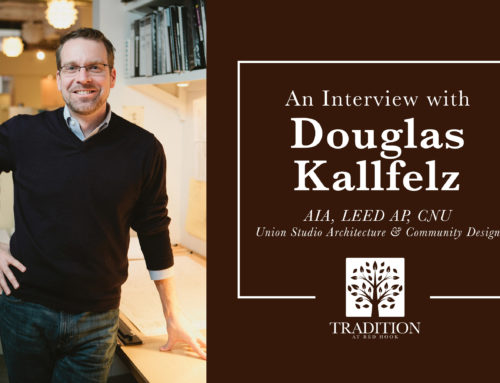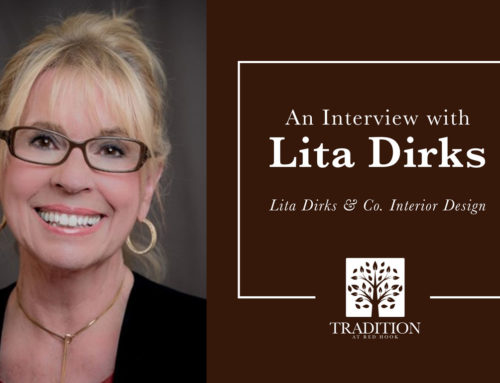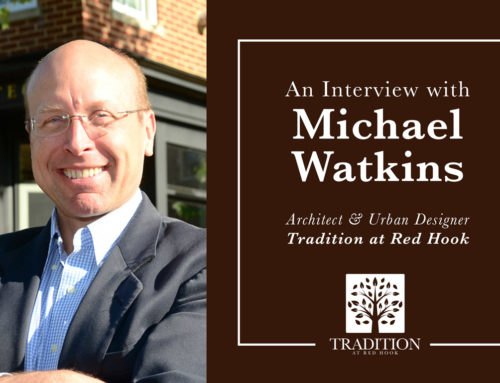Before joining the Tradition at Red Hook team, Giovanni Palladino worked for a well-known national developer on several Traditional Neighborhood Development (TND) communities in New York, Virginia, South Carolina, and Connecticut. He speaks beautifully to the concept, and says that’s because he truly believes in it as a way of life. More of his thoughts here:
What do most love about working on a Traditional Neighborhood Development (TND) project?
What I love about the TND concept is that it makes an old way of thinking new again. It’s planning and developing the way our world used to do things – before the age of sprawl. I believe the reason new urbanism has taken a foothold is because it’s pushing back on the last sixty-plus years of sprawl development. Some people call the TND movement one of smart growth, but the truth is, it’s so much more than that. TNDs are not just about the physical environment. We’re giving people opportunities to know their neighbors, and we’re creating destinations that attract people to be a part of something really cool. In the past, the development of these types of neighborhoods happened organically – today, we’re planning for it.
What makes Tradition at Red Hook so special, and what do you think is significant about the choice to do this in a very small, historic town?
I worked on the first TND in New York State (and quite possibly in the entire Northeast). It became a catalyst to reintroduce people to old planning ideas and principles. What I love about Tradition at Red Hook is that the plan creates community. And it’s also an opportunity to showcase the northern part of the Hudson Valley, especially Northern Dutchess. It represents exactly what people love about great little villages like Red Hook, Rhinebeck, and Beacon – but it’s new. And we get to reintroduce architecture based on traditional principles. For the last several decades, most architecture looks the same. As someone with a background in historical preservation, I have to wonder if many of the developments from the past 40-50 years are going to be preserved in the years to come? 70 years from now, will people be lined up in a cul-de-sac to protect the homes of the late 20th century and early 21st century? For the most part, probably not. But with a Traditional Neighborhood Development like Tradition at Red Hook, there’s something really special that’s being created that people will want to protect in the same way they want to preserve historic small towns like Red Hook.
What makes the Traditional Neighborhood Development concept so appealing to prospective homeowners?
It offers a return to village living – which means an opportunity to really know and engage with your neighbors. You can walk through your neighborhood and enjoy things you won’t typically see in a conventional subdivision, like sidewalks, open courtyards for events, and porches for conversation. A good example of the TND planning thought process is our Mail House at Tradition at Red Hook. In a typical development, people go to a set of metal boxes with their keys to get their mail. But to us, building an actual Mail House creates an opportunity to introduce a civic use. The Mail House is really an icon that represents the whole project, which is why it sits at the opening of our Green. It’s like a beacon that says, “You’ve arrived someplace special, where people can gather and meet neighbors.” It captures the essence of Tradition at Red Hook, representing what we’ve done on a micro level to create a sense of belonging.
Tell me about the significance of the Green.
When you make turn into Tradition at Red Hook from Old Farm Road, the Green opens the community to the rest of the town, and vice versa. We welcome that connection to the community. The Green could’ve been anywhere, set way back – but we deliberately picked that location up front; in fact, we actually started with that. The Mail House sits on the front of the Green, like a marker that tells you that you’ve arrived someplace different, while also being functional and based on the same architectural vernacular as the rest of the community. The front porch is inviting for people, whether they are walking on the sidewalks outside Tradition, or sitting on the Green inside. Together, the Mail House and the Green offer a place for a band to play live music, a place to hang a screen for movies, or a stage for a poetry reading. That Mail House is not just a Mail House – the Green is not just a Green – both engage with everything.
Why do you feel this is the perfect time to bring the TND concept to the Hudson Valley region?
I think this is where things are going; I believe this is what people want. My generation grew up amidst suburban sprawl. Even though I lived in an urban setting, most of my friends lived on two-acre lots on cul-de-sacs. People want walkable lives. It’s a healthier lifestyle. And it’s smarter and greener because it saves open space by creating density in a small area. And most of all, it brings people back into the equation.
What is your expectation as far as growing popularity of TNDs like Tradition at Red Hook?
When people want someplace special to go, they head into a village. When you think about Red Hook, Rhinebeck, or Beacon, this is what people love to experience, and it’s exactly what we’re creating. People want more than a dead-end subdivision. They want to be part of an entire community – they want to be engaged. And people are starting to understand the significance of good architecture. My wife watches HGTV all the time and you often hear someone say, “I want a house that has character.” Well, what is character? You go to a house with a beautiful front porch, columns, and beautiful details and you can’t help but think, “Wow. This is something unique. I want to live here!” Every home is tastefully planned, and everything about this community is connected, it’s not just one piece.
Tradition at Red Hook is a project of very high integrity thanks to the team that was assembled to make this vision a reality. Tell me more about the people involved.
We brought in one of the best TND planners in the country by the name of Mike Watkins (Michael Watkins, Architect). So starting off with the actual plan itself, we were on a very strong foundation. He’s completed TNDs all over the country. Bringing in the right planner gets you started on the right foot, because then you can engage others to see how these homes will work in context of the neighborhood, each street, and within the context of the plan itself. Having Union Studios, who designed the homes themselves, made all the difference; they are one of a handful of firms who can achieve this successfully. And of course Joe Kirchhoff and Joe Bonura had the foresight and have the understanding that this is potentially a game-changer in terms of how things are being done in the Hudson Valley. They realized Tradition at Red Hook is an opportunity to show people who might not be familiar with a TND all of the benefits that it brings with it. We’ve got a very talented team of experts – from those who envisioned it to the people who have made it all happen. Every person involved is very familiar with the importance of the details and significance of the architecture.
Tell me about the team’s discerning taste in materials.
I think the materials we’ve chosen for Tradition at Red Hook are great not only from a maintenance standpoint, but they speak to the importance of having traditional styles and patterns. Everything is of the highest quality. If you touch our columns, you’ll see that they’re real. When you go to someone’s door, you’re in direct contact with building materials, and because of the close proximity to sidewalks, it’s important that every material used on the home is authentic. For example, we use a simulated divided light on windows; the grill is outside the glass to give feel of historic windows. You get a shadow on it because of that. Shutters are working, functional shutters, and are proportionate to the window size. All of the little details are well-thought-out. Porches are 8 feet deep so you can furnish them and have real conversations with your neighbors out there. Porch rails are lower than you would typically see because we want people as they’re walking by to say, “Hey neighbor” and have a lower railing which invites conversation. That’s the level of detail incorporated into planning each and every choice we’ve made with designing and selection of materials.
What is your favorite house style at Tradition, and why?
That’s like asking me, “Which one of your kids is your favorite?!” They’re all different. I adore and love the Mail House because of what it symbolizes. I am passionate about traditional architecture – even if it’s not completely pure, I like that it’s based on traditional patterns. The Baldwin is stunning, but I also love the Cottage too. I think they’re cool and people are leaning toward smaller houses today; they’re these little gems in a larger project. But every style is great its own reasons. Homeowners can enjoy a home they love and be a part of a real community, which is what makes it so special.




